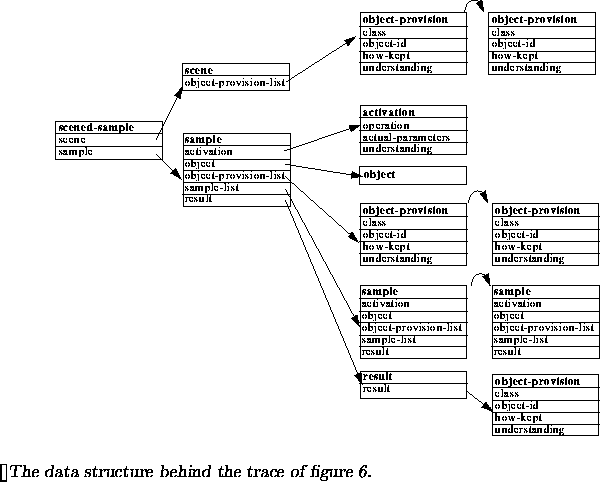



In the book ``Seamless Object-oriented Software Architecture - Analysis and Design of reliable Systems'' [4] Nerson and Waldén devote a chapter to description of dynamic models in the BON notation. They first describe a number of ``event charts'' and other charts (which are just tables with selected relations among elements in a dynamic model). They reject state transition diagrams and finite state machines as the only formalism for description of dynamic models because of the mismatch between static OO models and state transition diagrams. Following that they develop a scenario concept and they introduce some simple diagrams, through which a number of objects and `message relations' (in terms of arrows) among objects are drawn. The temporal aspects are captured by numbers on the message relations.
As an interesting idea, Nerson and Waldén introduce the concept of an object group which can take part in message relations. Object groups simplify the diagrams of dynamic models, and object groups can be seen as abstractions of a number of objects with similar properties. One usage of object groups is indeed to group together objects which are instances of a common, general class. The grouping of objects may be a first step in the direction of classification, and may consequently lead to generalization/specialization in the static model.
In contrast to our approach, Nerson and Waldén's work is quite heavily focussed on the means of expression. Their work is primarily a diagraming technique for expressing dynamic models. The degree of formalization is rather low in the BON notation. This in also in contrast to our approach, in which formal and informal aspects complement each other. The BON notation is at a slightly higher level of abstraction than our proposal. This is mainly due to the generality of the BON message relations, which are (n-n), and due to the object grouping concept.

Figure 8 shows a simple example of a dynamic model formulated in the BON notation. In order to compare this with our approach, we show a trace of our similar representation of the example in figure. We start with the driver and the car on the scene, and we introduce the owner via a provision of a global object at a later time, when the owner becomes necessary for the example. As another difference, we also provide an explicit key object. Notice that it is difficult to deal with object instantiation in the BON notation. The reason is, of course, that a diagram contains a fixed set of object (and a fixed set of message relations). In that sense the dynamic model is static. This is in contrast to our representation of a dynamic model, in which it is possible to prescribe new object creations as a function of time, during the development of the scenario.
The weakness of the BON notation with respect to object creation becomes even more clear if we attempt to make a diagram of the circle construction scenario, which we described in section 4.3. Figure 10 shows an attempt. In this example there are several point objects and several line objects involved which all can be seen on the figure. The roles of the different objects are given as group names. As noticed above it is not possible to illustrate how objects are created as the result of messages. This is a severe limitation in this example, because most of the objects are not `on the scene' at the beginning of the scenario. In addition, there are many objects in this example that never receive any message, with which we are concerned. These objects are parameters to the messages involved. The actual parameters of the messages cannot be shown in the BON notation. In summary we do not think that the diagram in figure 10 gives a good account of the dynamics of the circle construction.


